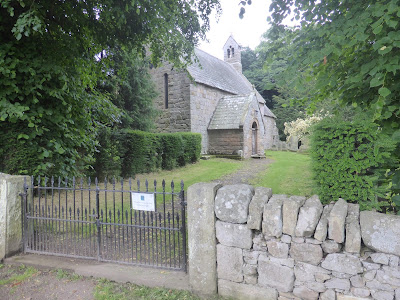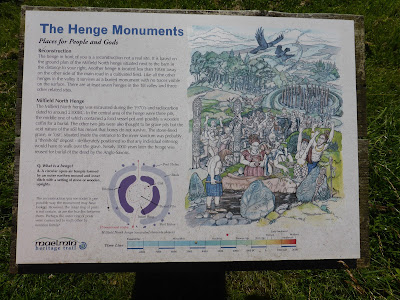The people who built Duddo stone circle (above) were probably working to some worldview but we have only vague ideas about what that perspective was. Humanity has always been challenged with the task of making comprehensive worldview level sense of its environment; but epistemic problems have impeded success and gaps have been filled with intolerance and dogma. But as we see below the error of fundamentalist scripturallism is not the answer to those epistemic difficulties - far from it!
Some solutions ameliorate one problem only to introduce another. An example is sickle cell hemoglobin which helps suppress the symptoms of malaria but increases the risk of sickle cell anemia. In circumstances like this there is tension between the advantages and disadvantages of alternative outcomes as they are weighed against one another and some trade-off settled for. There is, I believe, a tension of this type in the epistemic heuristic inherent in the mental make up of human beings.
Human beings, it hardly need be said, are in the main social animals and this confronts them with one of their greatest epistemic challenges; that is, attempting to interpret the output of the most complex object known to man, namely the human mind. But the task of trying to read other minds is carried out routinely on the hoof and is a highly informal process. No doubt we have large packages of both soft and firm cognitive neural-ware which address this problem, particularly in the realm of reading the meaning of language. Human beings offer few observational clues as to what they are thinking even when they use language to express themselves. Hence, in this connection human epistemic techniques have to join a paucity of evidential data-dots in order to arrive at highly complex conclusions about fellow humans. The epistemic process of predicting the otherwise hidden complexities of the human mind is likely to be very seat-of-the-pants. It is a miracle, however, that the process of mutual understanding works as well as it does, but there is a likely trade-off: The gains of getting it right outweigh the losses of making occasional (perhaps even frequent) mistakes. So it is likely that our neural-ware interpreter is balanced between the huge advantages of correctly understanding fellow human beings and an inevitable background noise of error. This human epistemic system is tuned on a knife edge and it's no surprise that in some individuals the inter-human neural package seems to malfunction badly: Autistics tend to under-interpret incoming data and paranoiacs over interpret it.
It is something akin to this very high risk neural-ware package which, I propose, is in operation during worldview synthesis. Unlike formal science which proceeds at a snails pace starting with basic and relatively simple systems and tries to build from the bottom up (see Brian Cox's comments here), worldview synthesis much more resembles the task of attempting to see behind the scenes into the human mind; this comprehensive epistemic process takes in a huge sweep of life experience as it tries to affirm very broad conclusions using methods that are informal and themselves often nigh on inscrutable. Highly ambitions conclusions, sometimes bordering on pretension and audacity, are arrived at. Worldview synthesis leaps well-ahead of formal science in ambition and vision, but the trade-off is that the risks of error, error often exacerbated by hubris, vested interest and tribal factors to name but a few perturbing influences, are balanced against the promise of an epistemic gold-mine. But let me point out the irony I've noted before; it is in fact an empirically based process in as much as it attempts to join the dots of experiential data, albeit rather creatively (See links below). In short the whole system of worldview synthesis isn't a robust process!
However, we can but try. I'm the last person to condemn attempts at sweeping worldview synthesis; if we are looking for comprehensive understandings of the world we may have little choice but to engage in this activity along with its risks; it might produce high gains in the long run. The trick, I believe, is not to do away with the mythological imagination but to be aware of its operation and above all to use it with a good measure of cautious epistemic humility in order to avoid the pitfalls of misplaced hubris and arrogant certainty. But in spite of worldview synthesis being so seat-of-the-pants it is ironic that the mythological imagination is inclined to invest in its highly attenuated constructions far more certainty than they warrant; in fact it is almost as if these constructions become more real than the basic perceptions on which they are built. Pathological examples are easy to find: the Flat Earth conspiracy, David Ike's lizard conspiracy, Alex Jones' conspiracy theories, numerous Christian fundamentalist world views, Jones Town, and fascism. It is the certainty and blinkered single mindedness with which world-views may be held that gives them the potential to be highly dangerous; much more dangerous might I add than even the problems introduced by the unbridled ambitions of status-seeking. The latter is unlikely to be so sweeping as to attempt to assimilate the whole cosmic coboodle into one seamless narrative: The realpolitik of self-centred status seeking has a limited horizon and a limited agenda in its striving for hegemony, whereas mythological fundamentalism seeks a much more thoroughgoing world take-over; one that includes the very hearts and minds of those it seeks to dominate.
In modern times scriptural fundamentalism (a subject which concerns me deeply) believes it can eliminate epistemic risk with a simple formula; Viz: God's Word says so & so, therefore so & so is absolutely certain to be true. But this epistemic has a very serious flaw: It fails to take into account that the natural language in which scripture is couched is far from being a direct revelation of truth. (See here, and here). As I have repeatedly made the case, natural language works by connotation and as such its interpretation taps into to a bottomless reservoir of facts taken from of human social history and the human context in general. Scripture can not be read like a mathematical text book where formality strives to obviate ambiguity and limit terms of reference; reading scripture is far more akin to the process of interpreting the natural linguistic output of other minds. Scriptural fundamentalists seek the security of certainty and authority; they cannot accept that there is a huge fallible human link in the chain when it comes to interpreting scripture. This fallible link is evidenced by the many contradictory forms that fundamentalism can take. See here, here and here.
However, we can but try. I'm the last person to condemn attempts at sweeping worldview synthesis; if we are looking for comprehensive understandings of the world we may have little choice but to engage in this activity along with its risks; it might produce high gains in the long run. The trick, I believe, is not to do away with the mythological imagination but to be aware of its operation and above all to use it with a good measure of cautious epistemic humility in order to avoid the pitfalls of misplaced hubris and arrogant certainty. But in spite of worldview synthesis being so seat-of-the-pants it is ironic that the mythological imagination is inclined to invest in its highly attenuated constructions far more certainty than they warrant; in fact it is almost as if these constructions become more real than the basic perceptions on which they are built. Pathological examples are easy to find: the Flat Earth conspiracy, David Ike's lizard conspiracy, Alex Jones' conspiracy theories, numerous Christian fundamentalist world views, Jones Town, and fascism. It is the certainty and blinkered single mindedness with which world-views may be held that gives them the potential to be highly dangerous; much more dangerous might I add than even the problems introduced by the unbridled ambitions of status-seeking. The latter is unlikely to be so sweeping as to attempt to assimilate the whole cosmic coboodle into one seamless narrative: The realpolitik of self-centred status seeking has a limited horizon and a limited agenda in its striving for hegemony, whereas mythological fundamentalism seeks a much more thoroughgoing world take-over; one that includes the very hearts and minds of those it seeks to dominate.
In modern times scriptural fundamentalism (a subject which concerns me deeply) believes it can eliminate epistemic risk with a simple formula; Viz: God's Word says so & so, therefore so & so is absolutely certain to be true. But this epistemic has a very serious flaw: It fails to take into account that the natural language in which scripture is couched is far from being a direct revelation of truth. (See here, and here). As I have repeatedly made the case, natural language works by connotation and as such its interpretation taps into to a bottomless reservoir of facts taken from of human social history and the human context in general. Scripture can not be read like a mathematical text book where formality strives to obviate ambiguity and limit terms of reference; reading scripture is far more akin to the process of interpreting the natural linguistic output of other minds. Scriptural fundamentalists seek the security of certainty and authority; they cannot accept that there is a huge fallible human link in the chain when it comes to interpreting scripture. This fallible link is evidenced by the many contradictory forms that fundamentalism can take. See here, here and here.
Selfish human ambitions which seek after high status without regard to the welfare of society as a whole are potentially toxic, but things can be worse. The empires of status seekers are not quite so comprehensive as the ambitions of fundamentalist idealists who seek a mental empire of believers which they wish to draw in and submit to the narrative constructed in fundamentalist minds. So, on balance I fear the dogmatic worldview builders more than those with plain and simple social status ambitions and whose scope of operation is likely to only go as far as realpolitik.
Human beings have an incredible ability to read imaginatively behind the scenes; we only have think of theoretical geniuses like Newton and Einstein who have scored big in this area. But against that we must set the many whose theories have failed and been forgotten (which probably includes my own!).
The theoretical imagination, especially when extended to vagaries of worldview synthesis, comes with risks. This is not to say we should avoid braving the deep waters of worldview synthesis - far from it - we just need to proceed with a little cautious epistemic humility - that and a little faith. We work out our salvation with fear and trembling.
Epistemology links:
http://quantumnonlinearity.blogspot.co.uk/2016/09/epistemic-notes_14.html
http://quantumnonlinearity.blogspot.co.uk/2014/08/the-great-epistemic-tradeoff.html
More pictures from Northumberland
The rain shrouded and ancient Cheviot hills convey a mood apposite to the mysteries of the meaning of creation.
To the uninitiated the highly asymmetrical ruins of Lindisfarne priory would present a mystery as deep as Duddo stone circle.
Weathering of the stones of the priory has created forms just as fantastic as the stones at Duddo.
The view from Ford church; It conjures up thoughts of ancient origins, beauty, light, colour and the truncation of death. These thoughts mingle prompting the feeling it must all mean something, thereby fueling the mythological imagination.
To the unknown god: A flower offering (?) found in one of the erosion channels of the Duddo stones. The offering instinct goes deep.
This isn't Northumberland but the Chinese "shrine" at Kew Gardens, where the floor has become covered in coin "offerings". Ornamental ponds often attract the same behavior. What's at the bottom of these token "offerings"? Is it carried out instinctively or is it done with the conscious intention of hedging bets and attempting a communion with unknown spiritual forces?




















